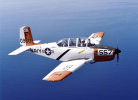- Joined
- Jun 7, 2008
- Messages
- 4,901
- Location
- Indian Hills Airpark Salome, AZ
- Display Name
Display name:
N1431A
Due to the recent posting of a T-34 crash, I was reminded of something concerning the T-34 that I have wondered about,
The T-34 rudder has a small triangular section cut out at the bottom. When the plane is converted for civilian use that triangular section is filled in with a piece that is riveted to the tail cone.
Why? What difference does that small piece make?
Thanks
The T-34 rudder has a small triangular section cut out at the bottom. When the plane is converted for civilian use that triangular section is filled in with a piece that is riveted to the tail cone.
Why? What difference does that small piece make?
Thanks



